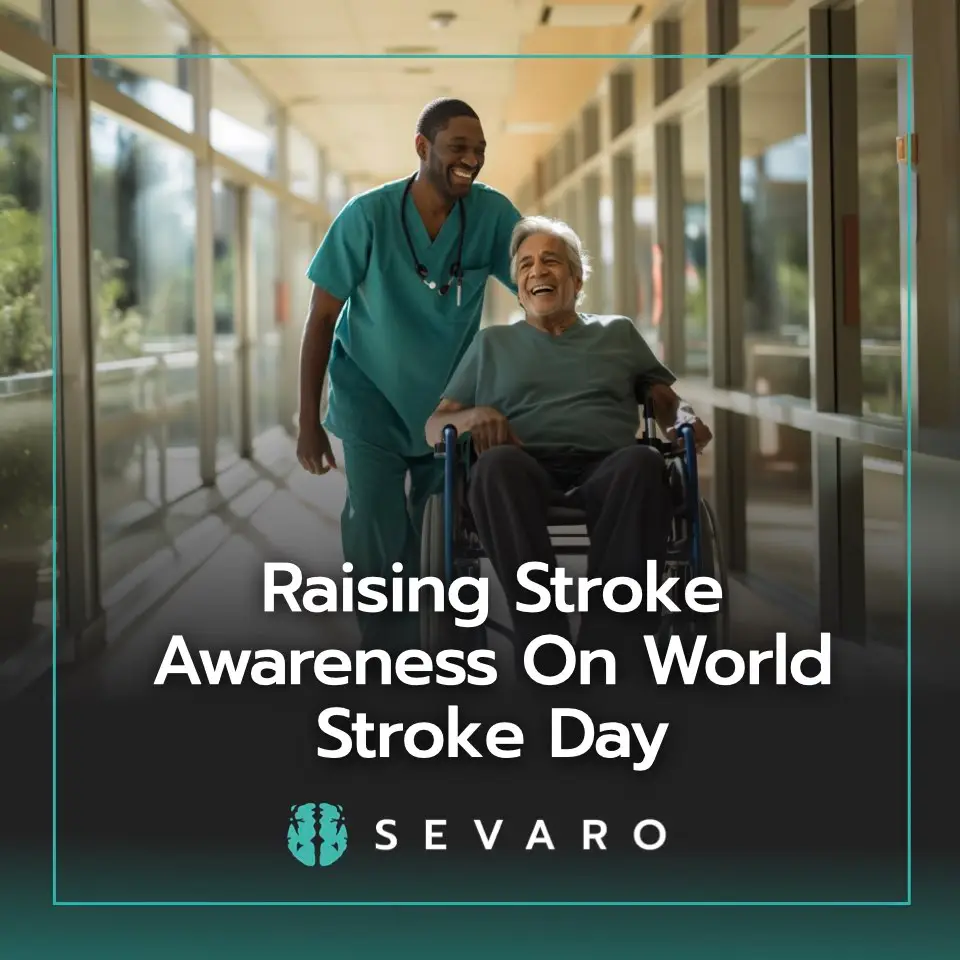
World Stroke Day is a day when we can come together and raise stroke awareness. At Sevaro, we are dedicated to educating the public about stroke awareness and affecting more positive patient outcomes through data-driven teleneurology.
Many factors contribute to having a stroke. The most common factor is age. Other risk factors include a family history of strokes or diabetes (which can cause cardiovascular issues).
There are a few key symptoms you can look for if you think someone is having a stroke. The most common one is paralysis or weakness in the face, arm, and leg. They might also have slurred speech or confusion that doesn’t alleviate quickly. If someone experiences any of these symptoms, then immediately dial 911.
A good acronym to remember is BE-FAST, which stands for:
Check to make sure they can stand and walk. If there are significant issues with either, then call 911 immediately.
Do their eyes look uneven or asymmetrical? This could indicate neurological impairment.
Has their face drooped on one side since you’ve seen them last? Does it drop when they try to smile or speak? This can mean something is wrong with facial muscles, so get medical attention as soon as possible if this happens.
Do they have any noticeable arm or leg weakness or numbness? If you ask them to lift their arms, notice if one arm drifts downward.
Is speech slurred at all? Are they having trouble speaking normally, even though body movements appear fine (i.e., they can walk and stand perfectly)? This could be a sign of impaired speech, which is critical to pay attention to because the person might appear fine otherwise.
Have someone call 911 right away instead of waiting, especially if this has happened more than once in the past. The faster medical professionals know what’s going on and can initiate treatment, the better chance the patient will survive and have fewer long-term side effects.
There are many different treatments for strokes, but the most common is an injection of tPA medication into a vein. tPA stands for tissue plasminogen activator, and it is the only stroke treatment that breaks up clots in the brain that are negatively affecting blood flow to certain parts of the brain.
Even if the patient survives a stroke, they may have long-lasting problems with their brain for months or even years after it happens. Not every patient’s recovery journey is alike, so this is why medical professionals will recommend physical therapy and other forms of rehabilitation to help them get back on track as quickly as possible.
Some top recovery options for stroke survivors include:
This might include walking, using specific muscles or limbs that have been affected by the stroke, and working on strengthening their balance.
Occupation therapists can help stroke survivors restore their ability to perform daily functions, such as grooming, cooking, and doing household chores. Repetitive activities help the survivor relearn how to conduct necessary tasks. An occupational therapist might break up the task into smaller activities and repeat each one, then, the survivor will perform the entire task in sequence.
Another option is speech therapy, where patients go through different exercises designed specifically for helping stroke patients restore communication skills.
Hospitals and rehab centers can be costly, which is why many patients will prefer to go home after they’ve been discharged. This might mean having family members or friends help take care of them until they’re able to do specific activities of daily living (like feeding, dressing, and bathing themselves). Some professionals come into the patient’s home for a few hours each day to make sure nothing gets overlooked as far as medical needs go, while someone else could cover basic things like keeping the house clean and cooking meals if necessary.
Sevaro offers evidence-based telemedicine and, more specifically, telestroke services that help connect patients with a vascular neurologist within 45 seconds. Since strokes can kill 1.9 million neurons per minute and are the number one cause of disability among American adults, getting the best possible treatment as fast as possible is essential.
Learn more about Sevaro and how we can be your trusted hospital partner.